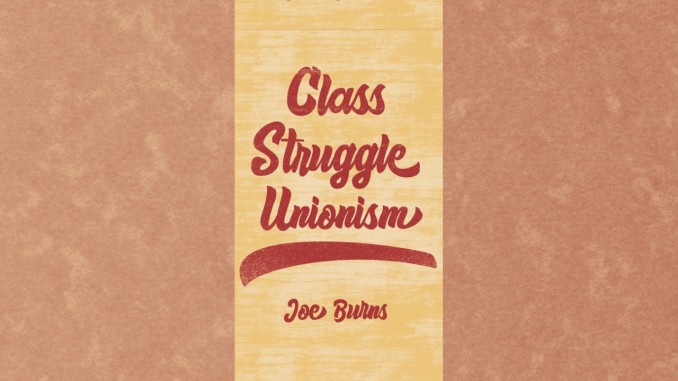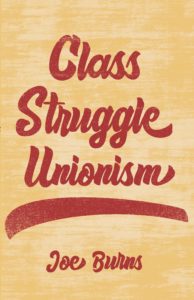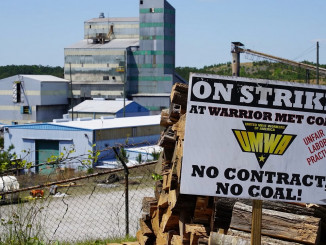
Speak Out Now is pleased to repost this review by Adam Shils of Joe Burns’ new book, Class Struggle Unionism (Haymarket, 2022). The review was originally published online by the International Socialism Project on April 22. We value Burns’ categories contrasting business unionism, labor liberalism, and class struggle unionism, as well as Shils’ critique of Burns’ attitude toward the Democratic Party and Bernie Sanders. We post reprints like this to call attention to important ideas that might influence working class and other organizing, whether we agree with those ideas wholeheartedly or not, and to stimulate constructive discussion of topics under debate within the left.
Last year, the hopes of a strike wave in October—which many called “Striketober”—produced thousands of articles. The Staten Island Amazon union victory has sparked a flurry of new discussions on labor’s future. The Labor Notes conference will soon take place in Chicago. This will be the largest meeting of the labor left since before the pandemic. In this situation, the left wing of the labor movement has desperately needed a lively and up to date restatement of our perspectives. We now have one.
That class struggle manifesto is Joe Burns’s new book, Class Struggle Unionism (Haymarket Books, Chicago, 2022). Joe is a well-respected labor activist and writer who has previously written the excellent books Strike Back and Reviving the Strike. His latest book will certainly provoke much discussion. The purpose of this review is to explain the main arguments in the book and why they are so welcome.
Business unionism
Class struggle unionism obviously begins by understanding what class struggle is. The book, therefore, starts off with a very clear explanation of how workers are exploited and the basic division of society into classes. Everything flows from the fundamental idea of “Them and Us.”
From this starting point Joe explains business unionism, the outlook of the traditional union bureaucracy. This outlook believes that management and labor have common interests and that collaboration will benefit both. Its advocates range from the archetypal labor bureaucrat, the AFL-CIO’s George Meaney, who bragged that he had “never walked a picket line” in his life, to modern supporters of “win- win” and interest-based bargaining.
Labor liberalism
For many years, class struggle unionists have worked in a movement dominated by business unionism. However, now there is a third fighter in the ring—labor liberalism. Here, the book covers some new and important ground.
Labor liberalism, exemplified by the Service Employees International Union (SEIU) and the Fight for 15 campaigns, uses the images of traditional labor action—strikes, pickets, and arrests. However, these actions are not carried out with the aim of building strong workers organizations in the workplace. Instead, their objective is gaining publicity for legislation or attempts to shame employers into “doing the right thing.” Now, labor legislation and bringing negative public pressure to bear on employers are legitimate components of an overall strategy. But the centerpiece of our strategy is building strong organizations in the workplace. This is what can force the bosses to back down.
Joe’s description of how labor liberalism uses workers as props will resonate with activists who have attended many recent demonstrations. I have been to many fast-food pickets where the union staffers and supporters easily outnumber the strikers. I’ve spoken with strikers who don’t know the plans for the strike and certainly haven’t had any role in deciding them. Picket line arrests sound militant, but I’ve often seen them calmly arranged beforehand with the police. Twice, I’ve seen SEIU staffers calmly collecting the citations after arrested picketers have been processed by the police. The union then pays the fine and no one is further bothered, not the courts and certainly not the employers.
Labor liberalism often sees workers as symbols of suffering who are to be pitied, not as the makers of their own future, part of a combative and organized movement. Labor liberals talk a great deal about new organizing, and that certainly is crucial. However, this is not done by organizing the workers themselves but by pressuring Democratic Party state legislatures to pass statutes allowing the workers to be unionized.
A clear example of this is the SEIU and home health care workers in Illinois. Here, the union’s central focus was getting then Governor Rod Blagojevich and the state legislature to designate home health care workers as public employees. Once, the necessary legislation was passed in Springfield, the sending out of authorization cards and the mail-in ballot was an administrative detail. This was part and parcel of the then SEIU leadership’s view that reaching agreements with elected officials and the healthcare industry was the way to increase union membership.
Class struggle unionism
Having examined the two alternatives and found them wanting, the book then turns to its centerpiece, the idea of class struggle unionism. Here we should let Joe speak for himself. He writes:
Class struggle unionists, rather than seeing our workers-owner relationship as primarily co-operative, but with occasional flare-ups, recognize that conflict is baked into an economic system that pits the interests of the working class against the employing class. This leads class struggle unionists to create a combative form of unionism that places sharp demands on the employers and promotes rank-and -file activism. (Page 19.)
Later, Joe explains, “We need the whole package: an explicit analysis of the billionaire class, a class-wide approach, class struggle ideology, and class struggle tactics. But we also need a plan and program to build a labor movement on those ideas.” (Page 101.)
Plan and program
If class struggle ideas are necessary, how can they be put into practice? The book goes through what needs to be done. Our unionism must be for the entire working class. This means putting the fight against racism at the forefront. It means boldly taking up gender discrimination. It means international solidarity and immigrant rights. It means independent class struggle politics.
Parenthetically, we would pose class struggle politics in a different way from Joe. He both starts and ends the book with a very positive evaluation of the electoral campaigns of the left inside the Democratic Party. In the Introduction he writes, “Today there are signs of hope…the growth of pro-working class politics represented by the Bernie Sanders campaign…” (Page 3). In the penultimate paragraph of the whole book, Joe writes how, “The campaigns of Bernie Sanders and Alexandria Ocasio-Cortez inspired millions to challenge a corrupt political system.” (Page 143).
It is true that AOC and Sanders have inspired millions to challenge the corrupt US political system, as Joe says. But at the same time, their campaigns sent the message that transformative social change can come through the Democratic Party. The Democratic Party is the vehicle by which the ruling class is able to absorb and disorientate potential opposition in this country. The party is a fundamental and intrinsic component of the US ruling class. In fact, it is one of the key means by which that class maintains its rule. For this reason, we see the campaigns of AOC and Bernie Sanders as part of the problem, not part of the solution. Socialists should therefore oppose each and every Democratic Party candidate straight across the board.
Winning strikes is at the center of class struggle unionism. Joe goes through the tactics needed here: stopping the input of goods and services, stopping the work process, preventing the distribution of goods and services, solidarity, and the confronting of injunctions.
Finally, this work looks at the organizers of class struggle unionism: the militant minority. Activists will be interested in the discussion of some of the main debates on the labor left today: how to relate to union leaders; can existing unions be transformed or are new organizations needed; the role of workers centers; and taking rank and file jobs versus staff jobs.
A weapon
Class Struggle Unionism is very well written and easy to read. The book is concise, the sentences clear, and the argument and chapters unfold in a systematic way.
This book is refreshingly free of the standard hype and exaggeration of much labor writing. The author has an honest and accurate view of the state of the class struggle. He describes the low levels of unionization, the defeats suffered since the 1980s, and the strengthening of the employers. Joe writes that, “The labor movement today is in miserable shape, probably worse than any period of labor history.” Hard words, but true.
In the 1930s, left wing book reviews would often end with the phrase, “This book is a weapon in the struggle.” This one really is.





